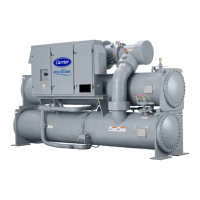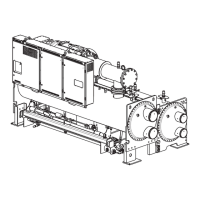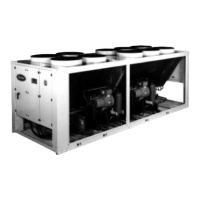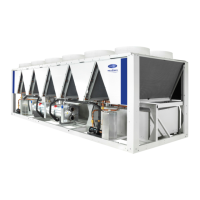45
ICE BUILD INITIATION — The ice build time schedule
(OCCPC02S) is the means for activating the ice build option.
The ice build option is enabled if:
• a day of the week and a time period on the ice build time
schedule are enabled. The SCHEDULE screen shows an
X in the day field and ON/OFF times are designated for
the day(s),
•
and
the
ICE BUILD OPTION
is enabled.
The following events take place (unless overridden by a
higher authority CCN device).
1.
CHILLER START/STOP
is forced to START.
2. The
CONTROL POINT
is forced to the
ICE BUILD
SETPOINT
.
3. Any force (Auto) is removed from the
ACTIVE
DEMAND LIMIT
.
NOTE: A parameter’s value can be forced, that is, the value
can be manually changed at the CVC by an operator, changed
from another CCN device, or changed by other algorithms in
the PIC II control system.
NOTE: Items 1-3 (shown above) do not occur if the chiller is
configured and operating as a lag or standby chiller for lead/lag
operation and is actively being controlled by a lead chiller. The
lead chiller communicates the
ICE BUILD SET POINT
, the
desired
CHILLER START/STOP
state, and the
ACTIVE
DEMAND LIMIT
to the lag or standby chiller as required for
ice build, if configured to do so.
START-UP/RECYCLE OPERATION — If the chiller is not
running when ice build activates, the PIC II checks the follow-
ing conditions, based on the
ICE BUILD TERMINATION
val-
ue, to avoid starting the compressor unnecessarily:
•if
ICE BUILD TERMINATION
is set to the TEMP
option and the
ENTERING CHILLED WATER
tempera-
ture is less than or equal to the I
CE BUILD SETPOINT
;
•if
ICE BUILD TERMINATION
is set to the
CONTACTS
option and the remote contacts are open;
•if the I
CE BUILD TERMINATION
is set to the BOTH
(temperature and contacts) option and the
ENTERING
CHILLED WATER
temperature is less than or equal to
the
ICE BUILD SETPOINT
and the remote contacts are
open.
The
ICE BUILD RECYCLE
on the OPTIONS screen deter-
mines whether or not the chiller will go into an ice build RE-
CYCLE mode.
• If the
ICE BUILD RECYCLE
is set to DSABLE (dis-
able), the PIC II reverts to normal temperature control
when the ice build function terminates.
• If the
ICE BUILD RECYCLE
is set to ENABLE, the PIC
II goes into an
ICE BUILD RECYCLE
mode and the
chilled water pump relay remains energized to keep the
chilled water flowing when the ice build function termi-
nates. If the temperature of the
ENTERING CHILLED
WATER
increases above the
ICE BUILD SETPOINT
plus the
RECYCLE RESTART DELTA T
value, the
compressor restarts and controls the chilled water/brine
temperature to the
ICE BUILD SETPOINT
.
TEMPERATURE CONTROL DURING ICE BUILD —
During ice build, the capacity control algorithm shall use the
CONTROL POINT
minus 5 F (–2.8 C) for control of the
LEAVING CHILLED WATER
temperature. See Table 3, exam-
ple 9, the
CAPACITY CONTROL
parameter on the CAPAC-
ITY screen.) The
ECW CONTROL OPTION
and any
temperature reset option shall be ignored, if enabled, during ice
build. The
AUTO DEMAND LIMIT INPUT
shall also be
ignored if enabled during ice build.
•
ECW CONTROL OPTION
and any temperature reset
options (configured on TEMP_CTL screen).
•
20 mA DEMAND LIMIT OPT
(configured on
RAMP_DEM screen).
TERMINATION OF ICE BUILD — The ice build function
terminates under the following conditions:
1. Time Schedule — When the current time on the ice
build time schedule (OCCPC02S) is
not
set as an ice
build time period.
2. Entering Chilled Water Temperature — Compressor
operation terminates, based on temperature, if the
ICE
BUILD TERMINATION
parameter is set to 0 (TEMP),
the
ENTERING CHILLED WATER
temperature is less
than the
ICE BUILD SETPOINT
, and the ICE BUILD-
RECYCLE is set to DSABLE. If the
ICE BUILD
RECYCLE OPTION
is set to ENABLE, a recycle shut-
down occurs and recycle start-up depends on the
LEAVING CHILLED WATER
temperature being
greater than the
WATER/BRINE CONTROL POINT
plus the
RECYCLE RESTART DELTA T
temperature
3. Remote Contacts/Ice Level Input — Compressor oper-
ation terminates when the
ICE BUILD TERMINA-
TION
parameter is set to 1 [CONTACTS] and the
remote contacts are open and the
ICE BUILD RECY-
CLE
is set to DSABLE (0). In this case, the contacts
provide ice level termination control. The contacts are
used to stop the ice build function when a time period
on the ice build schedule (OCCPC02S)
is
set for ice
build operation. The remote contacts can still be
opened and closed to start and stop the chiller when a
specific time period on the ice build schedule is
not
set
for ice build.
4. Entering Chilled Water Temperature and ICE BUILD
Contacts — Compressor operation terminates when
the
ICE BUILD TERMINATION
parameter is set to 2
(
BOTH
) and the conditions described above in items 2
and 3 for entering chilled water temperature and
remote contacts have occurred.
NOTE: It is not possible to override the
CHILLER START/
STOP, CONTROL POINT
, and
ACTIVE DEMAND LIMIT
variables from CCN devices (with a priority 4 or greater) dur-
ing the ice build period. However, a CCN device can override
these settings during 2-chiller lead/lag operation.
RETURN TO NON-ICE BUILD OPERATIONS — The ice
build function forces the chiller to start, even if all other sched-
ules indicate that the chiller should stop. When the ice build
function terminates, the chiller returns to normal temperature
control and start/stop schedule operation. The
CHILLER
START/STOP
and
CONTROL POINT
return to normal opera-
tion. If the
CHILLER START/STOP
or
CONTROL POINT
has
been forced (with a device of less than 4 priority) before the ice
build function started, when the ice build function ends, the
previous forces (of less than 4 priority) are not automatically
restored.
Attach to Network Device Control —
The Service
menu includes the ATTACH TO NETWORK DEVICE
screen. From this screen, the operator can:
• enter the time schedule number (if changed) for
OCCPC03S, as defined in the NET_OPT screen
• attach the CVC to any CCN device, if the chiller has
been connected to a CCN network. This may include
other PIC- controlled chillers.
• upgrade software
Figure 27 shows the ATTACH TO NETWORK DEVICE
screen. The
LOCAL
parameter is always the CVC module ad-
dress of the chiller on which it is mounted. Whenever the con-
troller identification of the CVC changes, the change is reflect-
ed automatically in the BUS and ADDRESS columns for the
local device. See Fig. 21. Default address for local device is
BUS 0 ADDRESS 1.

